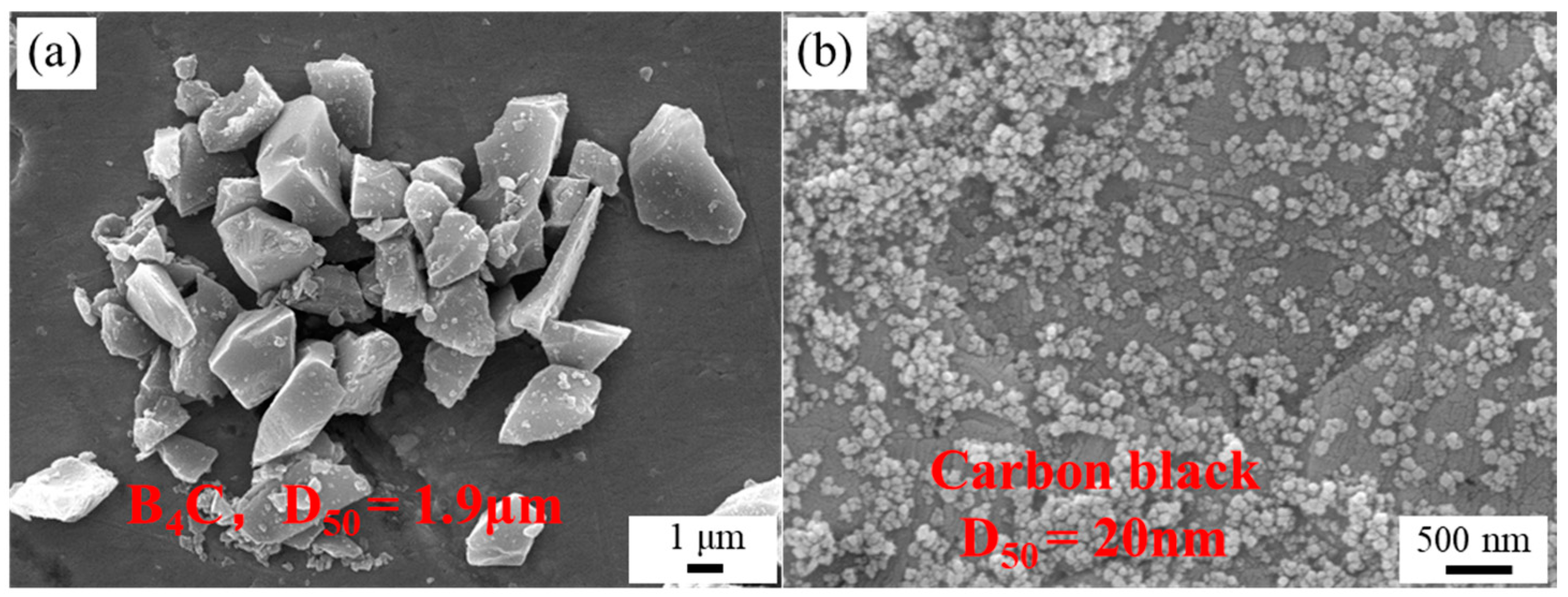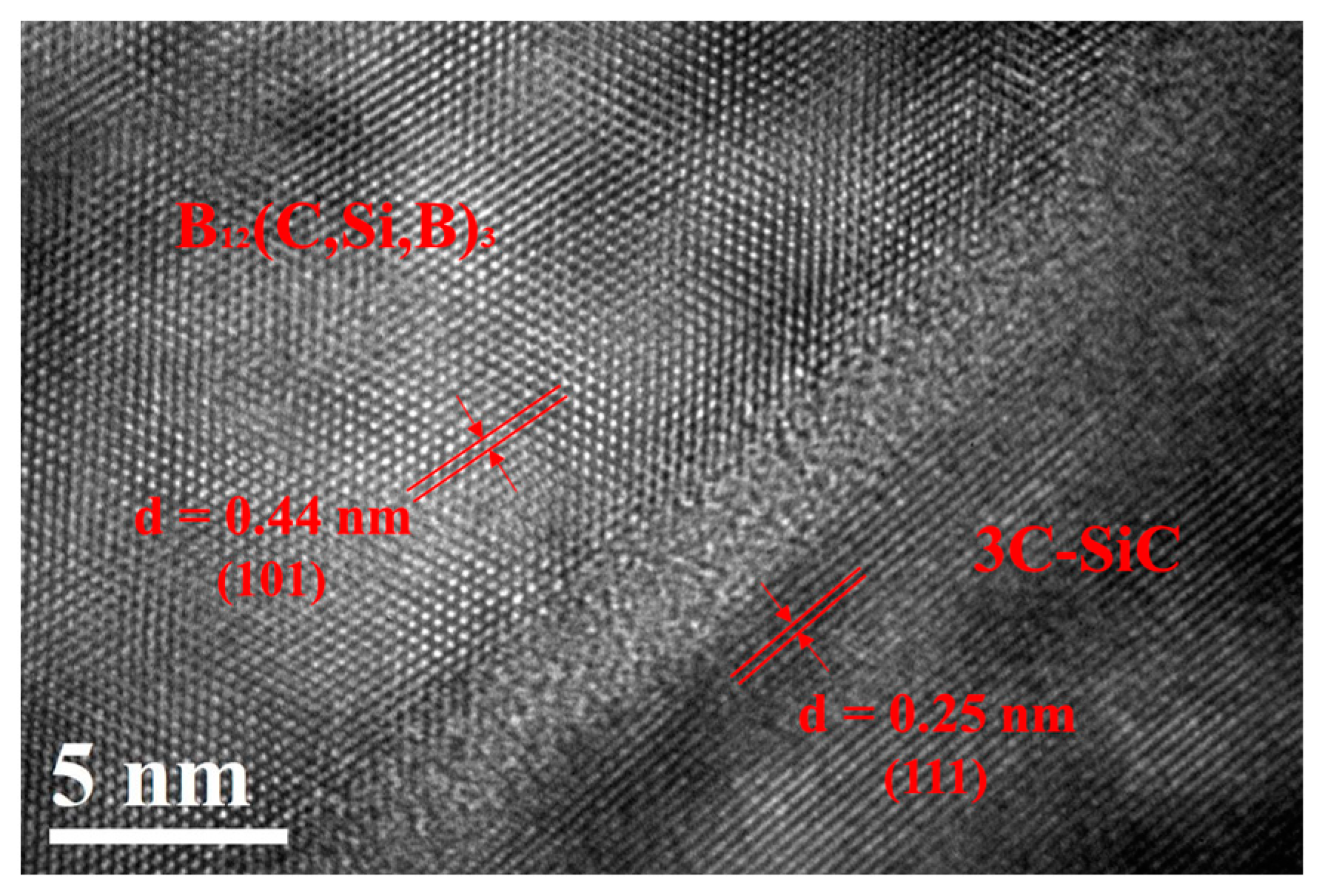Continuous SiC Skeleton-Reinforced Reaction-Bonded Boron Carbide Composites with High Flexural Strength
Abstract
1. Introduction
2. Materials and Methods
2.1. Raw Materials and RBBC Composites Preparation
2.2. Characterization Technique
3. Results
3.1. Phase Compositions
3.2. Microstructure of RBBC Composites
3.3. Density and Open Porosity
3.4. Mechanical Properties
4. Conclusions
Author Contributions
Funding
Institutional Review Board Statement
Informed Consent Statement
Data Availability Statement
Conflicts of Interest
References
- Wood, C.; Emin, D.; Gray, P.E. Thermal conductivity behavior of boron carbides. Phys. Rev. B 1985, 31, 6811–6814. [Google Scholar] [CrossRef] [PubMed]
- Misra, A.K.; Greenbauer-Seng, L.A. Aerospace propulsion and power materials and structures research at NASA glenn research center. J. Aerospace. Eng. 2013, 26, 459–490. [Google Scholar] [CrossRef]
- Yue, X.Y.; Huo, M.D.; Liu, J.Q.; Wang, J.J.; Ru, H.Q. Microstructure and properties of bilayered B4C-based ceramics. J. Eur. Ceram. Soc. 2022, 42, 3404–3414. [Google Scholar] [CrossRef]
- Savio, S.G.; Rao, A.S.; Reddy, P.R.S.; Madhu, V. Microstructure and ballistic performance of hot pressed & reaction bonded boron carbides against an armour piercing projectile. Adv. Appl. Ceram. 2019, 118, 264–273. [Google Scholar]
- Avcioglu, S.; Kaya, F.; Kaya, C. Effect of elemental nano boron on the transformation and morphology of boron carbide (B4C) powders synthesized from polymeric precursors. Ceram. Int. 2020, 46, 17938–17950. [Google Scholar] [CrossRef]
- Guo, W.C.; Wang, A.Y.; He, Q.L.; Tian, T.; Liu, C.; Hu, L.X.; Shi, Y.W.; Liu, L.S.; Wang, W.M.; Fu, Z.Y. Microstructure and mechanical properties of B4C -TiB2 ceramic composites prepared via a two-step method. J. Eur. Ceram. Soc. 2021, 41, 6952–6961. [Google Scholar] [CrossRef]
- Vargas-Gonzalez, L.; Speyer, R.F.; Campbell, J. Flexural strength, fracture toughness, and hardness of silicon carbide and boron carbide armor ceramics. Int. J. Appl. Ceram. Technol. 2010, 7, 643–651. [Google Scholar] [CrossRef]
- Mei, Z.; Zhou, Z.H.; Yuan, T.C.; Li, R.D.; Zhang, W.S.; Zhang, Y.J.; Wang, M.B.; Xie, S.Y. Analysis of abnormal grain growth behavior during hot-press sintering of boron carbide. Ceram. Int. B 2020, 46, 16345–16353. [Google Scholar]
- Neuman, E.W.; Hilmas, G.E.; Fahrenholtz, W.G. Pressureless sintering of zirconium diboride with carbon and boron carbide nanopowder. Ceram. Int. 2022, 48, 13071–13079. [Google Scholar] [CrossRef]
- Üsal, H.; Grasso, S.; Kovalíková, A.; Hanzel, O.; Tatarkova, M.; Dlouhý, I.; Tatarko, P. In-situ graphene platelets formation and its suppression during reactive spark plasma sintering of boron carbide/titanium diboride composites. J. Eur. Ceram. Soc. 2021, 41, 6281–6289. [Google Scholar] [CrossRef]
- Taylor, K.M.; Pallick, R.J. Dense Carbide Composite for Armor and Abrasives. U.S. Patent 3765300, 16 October 1973. [Google Scholar]
- Dariel, M.P.; Frage, N. Reaction bonded boron carbide: Recent developments. Adv. Appl. Ceram. 2012, 111, 301–310. [Google Scholar] [CrossRef]
- Hayun, S.; Weizmann, A.; Dariel, M.P.; Frage, N. The effect of particle size distribution on the microstructure and the mechanical properties of boron carbide-based reaction-bonded composites. Int. J. Appl. Ceram. Technol. 2009, 6, 492–500. [Google Scholar] [CrossRef]
- Xia, Q.; Sun, S.H.; Zhao, Y.L.; Zhang, C.P.; Ru, H.Q.; Wang, W.; Yue, X.Y. Effect of boron carbide particle size distribution on the microstructure and properties of reaction bonded boron carbide ceramic composites by silicon infiltration. J. Inorg. Mater. 2022, 37, 636–642. [Google Scholar] [CrossRef]
- Ren, Q.X.; Feng, D.; Ru, H.Q.; Jiang, Y.; Ye, C.C.; Zhang, Y.; Wang, W.; Zhang, C.P. Controllability of the pore characteristics of B4C/C preform prepared by gel-casting and the properties of RBBC composites. Ceram. Int. B 2019, 45, 22682–22687. [Google Scholar] [CrossRef]
- Lin, Q.Q.; Dong, S.M.; He, P.; Zhou, H.J.; Hu, J.B. Microstructure and property of TiB2 reinforced reaction-bonded B4C composites. J. Inorg. Mater. 2015, 30, 667–672. [Google Scholar]
- Wang, J.L.; Lin, W.S.; Jiang, Z.W.; Duan, L.H.; Yang, G.L. The preparation and properties of SiCw/B4C composites infiltrated with molten silicon. Ceram. Int. 2014, 40, 6793–6798. [Google Scholar] [CrossRef]
- Cafri, M.; Malka, A.; Dilman, H.; Dariel, M.P.; Frage, N. Reaction-bonded boron carbide/magnesium-silicon composites. Int. J. Appl. Ceram. Technol. 2014, 11, 273–279. [Google Scholar] [CrossRef]
- Alexander, R.; Ravikanth, K.V.; Bedse, R.D.; Murthy, T.S.R.C.; Dasgupta, K. Effect of carbon fiber on the tribo-mechanical properties of boron carbide: Comparison with carbon nanotube reinforcement. Int. J. Refract. Met. Hard Mater. 2019, 85, 105055. [Google Scholar] [CrossRef]
- Song, S.; Bao, C.; Wang, B. Effect of the addition of carbon fibres on the microstructure and mechanical properties of reaction bonded B4C/SiC composites. J. Eur. Ceram. Soc. 2016, 36, 1905–1913. [Google Scholar] [CrossRef]
- Solodkyi, I.; Bezdorozhev, O.; Vterkovskiy, M.; Bogomol, I.; Bolbut, V.; Krügerb, M.; Badica, P.; Lobod, P. Addition of carbon fibers into B4C infiltrated with molten silicon. Ceram. Int. 2019, 45, 168–174. [Google Scholar] [CrossRef]
- Karagedov, G.R.; Shutilov, R.A.; Kolesov, B.A.; Kuznetsov, V.L. The effect of carbon nanotubes introduction on the mechanical properties of reaction bonded boron carbide ceramics. J. Eur. Ceram. Soc. 2021, 41, 5782–5790. [Google Scholar] [CrossRef]
- Zhou, Y.C.; Ni, D.W.; Kan, Y.M.; He, P.; Dong, S.M.; Zhang, X.Y. Microstructure and mechanical properties of reaction bonded B4C-SiC composites: The effect of polycarbosilane addition. Ceram. Int. 2017, 43, 5887–5895. [Google Scholar] [CrossRef]
- Sun, M.Y.; Bai, Y.H.; Li, M.X.; Fan, S.W.; Cheng, L.F. In situ toughened two-phase B12(C,Si,B)3-SiC ceramics fabricated via liquid silicon infiltration. J. Am. Ceram. Soc. 2019, 102, 2094–2103. [Google Scholar] [CrossRef]
- Hayun, S.; Weizmann, A.; Dilman, H.; Dariel, M.P.; Frage, N. Rim region growth and its composition in reaction bonded boron carbide composites with core-rim structure. J. Phys. Conf. Ser. 2009, 176, 012009. [Google Scholar] [CrossRef]
- Zhang, C.P.; Ru, H.Q.; Zong, H.; Sun, W.K.; Zhu, J.H.; Wang, W.; Yue, X.Y. Coarsening of boron carbide grains during the infiltration of porous boron carbide preforms by molten silicon. Ceram. Int. 2016, 42, 18681–18691. [Google Scholar] [CrossRef]
- Hayun, S.; Frage, N.; Dariel, M.P. The morphology of ceramic phases in BxC-SiC-Si infiltrated composites. J. Solid State Chem. 2006, 179, 2875–2879. [Google Scholar] [CrossRef]
- Hayun, S.; Weizmann, A.; Dariel, M.P.; Frage, N. Microstructural evolution during the infiltration of boron carbide with molten silicon. J. Eur. Ceram. Soc. 2010, 30, 1007–1014. [Google Scholar] [CrossRef]
- Matthey, B.; Höhn, S.; Wolfrum, A.K.; Mühle, U.; Motylenko, M.; Rafaja, D.; Michaelis, A.; Herrmann, M. Microstructural investigation of diamond-SiC composites produced by pressureless silicon infiltration. J. Eur. Ceram. Soc. 2017, 37, 1917–1928. [Google Scholar] [CrossRef]
- Ness, J.N.; Page, T.F. Microstructural evolution in reaction-bonded silicon carbide. J. Mater. Sci. 1986, 21, 1377–1397. [Google Scholar] [CrossRef]
- Herrmann, M.; Matthey, B.; Höhn, S.; Kinski, I.; Rafaja, D.; Michaelis, A. Diamond-ceramics composites-New materials for a wide range of challenging applications. J. Eur. Ceram. Soc. 2012, 32, 1915–1923. [Google Scholar] [CrossRef]
- Yurkov, A.L.; Starchenko, A.M.; Skidan, B.S. Reaction sintering of boron carbide. Refractories 1989, 30, 731–736. [Google Scholar] [CrossRef]
- Barickn, P.; Jana, D.C.; Thiyagarajan, N. Effect of particle size on the mechanical properties of reaction bonded boron carbide ceramics. Ceram. Int. 2013, 39, 763–770. [Google Scholar] [CrossRef]
- Ellert, T.; Frage, N. On the effects of particle size and preform porosity on the mechanical properties of reaction-bonded boron carbide infiltrated with Al-Si alloy at 950 °C. Ceram. Int. 2020, 46, 18994–18999. [Google Scholar] [CrossRef]
- Lu, Q.; Zeng, X.Q.; Ding, W.J. The Hall-Petch relationship. J. Light Met. 2008, 8, 59–64. [Google Scholar]
- Zhang, X.R.; Zhang, Z.X.; Sun, Y.; Xiang, M.Y.; Wang, G.S.; Bai, Y.M.; Mu, J.B.; Che, H.W.; Wang, W.M. Preparation, micro-structure and toughening mechanism of superhard ultrafine grained boron carbide ceramics with outstanding fracture toughness. J. Alloys Compd. 2018, 762, 125–132. [Google Scholar] [CrossRef]
- Zhang, C.P.; Xia, Q.; Han, L.F.; Zhao, Y.L.; Huang, N.; Ren, Q.X.; Zhang, X.; Ru, H.Q. Fabrication of carbon-coated boron carbide particle and its role in the reaction bonding of boron carbide by silicon infiltration. J. Eur. Ceram. Soc. 2022, 42, 860–868. [Google Scholar] [CrossRef]
- Hayun, S.; Dariel, M.P.; Frage, N.; Zaretsky, E. The high-strain-rate dynamic response of boron carbide-based composites: The effect of microstructure. Acta Mater. 2010, 58, 1721–1731. [Google Scholar] [CrossRef]
- Ghatu, S.; Blair, R. Synthesis and Processing of Ultra High Hardness Boron Carbide. WIPO Patent 2014117071A1, 27 January 2014. [Google Scholar]
- Patel, M.; Subrahmanyam, J.; Prasad, V.V.B.; Goyal, R. Processing and characterization of B4C -SiC-Si-TiB2 composites. Mat. Sci. Eng. A 2010, 527, 4109–4112. [Google Scholar] [CrossRef]
- Sha, W.; Liu, Y.; Zhou, Y.; Huang, Y.; Huang, Z. Effect of Carbon Content on Mechanical Properties of Boron Carbide Ceramics Composites Prepared by Reaction Sintering. Materials 2022, 15, 6028. [Google Scholar] [CrossRef]
- Ren, Q.X.; Feng, D.; Ru, H.Q.; Jiang, Y.; Wang, W.; Zhang, C.P. Effects of a hierarchical macroporous–mesoporous structure with a low porosity porous ceramic preform on mechanical properties and Si particle refinement of RBBC composites. Ceram. Int. 2021, 47, 23444–23452. [Google Scholar] [CrossRef]









| Sample | Volume Density (g/cm3) | Open Porosity (%) | Residual Si (vol.%) |
|---|---|---|---|
| PC-RBBC | 2.63 | 0.2 | 27.5 |
| PF-RBBC | 2.58 | 0.4 | 34.9 |
| Reference | Method | Properties | |||
|---|---|---|---|---|---|
| Flexural Strength (MPa) | Fracture Toughness (MPa·m1/2) | Vickers Hardness (GPa) | Volume Density (g/cm3) | ||
| [22]-2021 | Carbon nanotubes addition | 585 | - | - | 2.58 |
| [21]-2019 | Carbon fiber addition | 510 ± 27 | - | - | 2.72 |
| present study | PEI disperse CB | 470 ± 29 | 4.6 ± 0.4 | 22 ± 0.7 | 2.63 |
| [37]-2022 | Carbon coated on boron carbide | 457 | 4.8 | 24 | 2.576 |
| [41]-2022 | Various carbon addition | 444 | 2.1 | 20.34 | 2.63 |
| [15]-2019 | Gel casting | 419 ± 17 | 4.12 ± 0.12 | - | 2.52 |
| [23]-2017 | Polycarbosilane addition | 319 ± 12 | 4.35 ± 0.05 | 17.3 ± 0.2 | 2.539 |
| [42]-2021 | Gel casting | 299 ± 17 | 4.09 ± 0.17 | 21 ± 3 | - |
| [24]-2018 | Tape casting | 245 ± 8 | 6.5 ± 0.5 | 20.2 ± 0.2 | - |
Disclaimer/Publisher’s Note: The statements, opinions and data contained in all publications are solely those of the individual author(s) and contributor(s) and not of MDPI and/or the editor(s). MDPI and/or the editor(s) disclaim responsibility for any injury to people or property resulting from any ideas, methods, instructions or products referred to in the content. |
© 2023 by the authors. Licensee MDPI, Basel, Switzerland. This article is an open access article distributed under the terms and conditions of the Creative Commons Attribution (CC BY) license (https://creativecommons.org/licenses/by/4.0/).
Share and Cite
Xia, Q.; Sun, S.; Ye, J.; Zhang, C.; Ru, H. Continuous SiC Skeleton-Reinforced Reaction-Bonded Boron Carbide Composites with High Flexural Strength. Materials 2023, 16, 5153. https://doi.org/10.3390/ma16145153
Xia Q, Sun S, Ye J, Zhang C, Ru H. Continuous SiC Skeleton-Reinforced Reaction-Bonded Boron Carbide Composites with High Flexural Strength. Materials. 2023; 16(14):5153. https://doi.org/10.3390/ma16145153
Chicago/Turabian StyleXia, Qian, Shihao Sun, Jun Ye, Cuiping Zhang, and Hongqiang Ru. 2023. "Continuous SiC Skeleton-Reinforced Reaction-Bonded Boron Carbide Composites with High Flexural Strength" Materials 16, no. 14: 5153. https://doi.org/10.3390/ma16145153
APA StyleXia, Q., Sun, S., Ye, J., Zhang, C., & Ru, H. (2023). Continuous SiC Skeleton-Reinforced Reaction-Bonded Boron Carbide Composites with High Flexural Strength. Materials, 16(14), 5153. https://doi.org/10.3390/ma16145153






